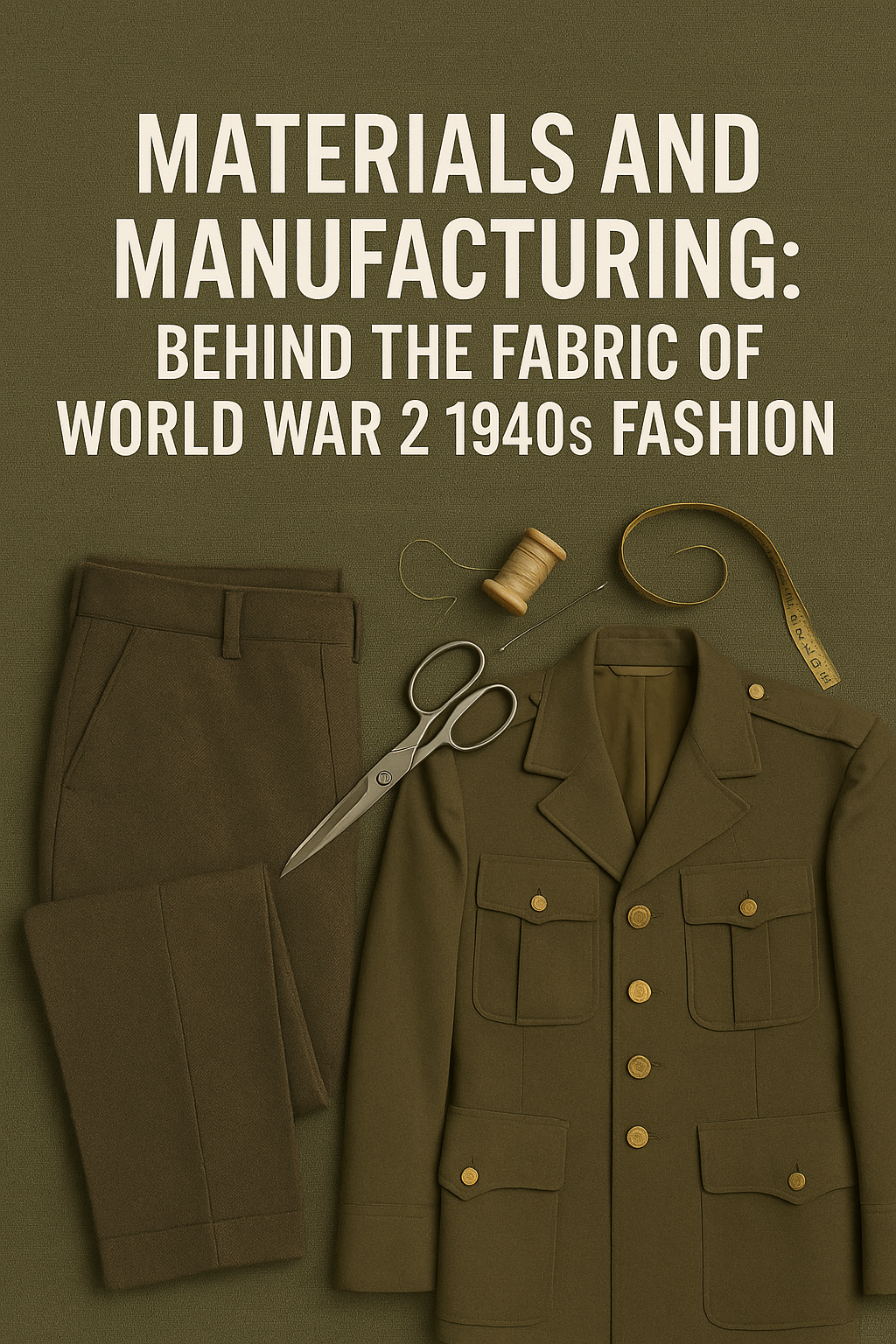
Materials and Manufacturing: Behind the Fabric of World War 2 1940s Fashion
Published on May 03, 2025
Materials and Manufacturing: Behind the Fabric of World War 2 1940s Fashion
Military uniforms are more than just garments; they are historical artifacts stitched with identity, discipline, and innovation. During World War 2, uniform manufacturing underwent major transformations that reflected not only military needs but also broader fashion and textile trends of the 1940s. This post explores the raw materials, production methods, and evolving standards that defined WW2 military attire, including the enduring legacy of wool trousers and modern applications like the Army Service Uniform (ASU) builder.
The Role of Uniforms in World War Fashion
Uniforms during World War 2 were utilitarian but surprisingly stylish. The 1940s era brought about distinctive military cuts, standardized patterns, and innovations in fabric technology, which have become iconic symbols of the time.
From the olive-drab field jackets to sharp officer dress uniforms, the garments served multiple purposes:
- Identification of rank and branch
- Protection against harsh weather
- Morale boosting and discipline
- Representing national pride and professionalism
Why Materials Mattered: Wool, Cotton, and Synthetics
Wool was the cornerstone of World War 2 1940s fashion, particularly in colder climates. Tightly woven wool serge or twill was used for trousers, jackets, and overcoats due to its:
- Insulating properties
- Durability
- Water resistance
- Fire resistance
WW2 wool trousers, in particular, were standard issue for U.S. and British soldiers alike. Their structure offered comfort, flexibility, and warmth, especially vital in trench warfare and harsh winters.
Cotton, another major fabric, was used in lighter uniforms and summer garments. Cotton fatigues, shirts, and undergarments provided breathability and comfort during long campaigns.
As the war progressed, synthetic materials like rayon and nylon started appearing, especially in parachute gear, linings, and, later, combat uniforms. These innovations helped reduce dependency on natural resources strained by wartime demands.
Manufacturing Uniforms at Scale: Wartime Efficiency Meets Precision
To outfit millions of soldiers, wartime governments collaborated with private textile companies to scale up production. Uniform manufacturing was driven by the following:
- Standardization: Uniform patterns were created to ensure consistency across troops.
- Mass production: Assembly-line techniques reduced production time and costs.
- Government contracts: Companies were commissioned to meet military specs down to the thread count.
Every stitch, seam, and button followed strict specifications. Soldiers could expect their trousers to have specific measurements, pleat placements, and reinforced stitching for long-term use.
WW2 Wool Trousers: Function Meets Form
A standout example of 1940s military fashion is the WW2 wool trousers. These trousers weren’t just practical; they also contributed to the iconic silhouette of a soldier.
Key features included:
- High waist and wide-leg fit for mobility
- Button fly closures
- Reinforced crotch and seat for durability
- Side and rear pockets for function
At Paddelaters, our authentic reproductions of WW2 wool trousers follow original military specs, offering enthusiasts and reenactors a chance to wear history.
World War 2 Uniforms and Civilian Fashion Influence
It’s impossible to discuss WW2 uniforms without acknowledging their influence on civilian fashion. As returning soldiers continued wearing their military pieces post-war, many features found their way into mainstream clothing:
- Trench coats became everyday wear
- The bomber jacket transitioned into casual menswear
- High-waist trousers inspired 1950s fashion
Thus, military manufacturing during WW2 didn’t just serve the battlefield—it shaped decades of fashion beyond it.
Army ASU Uniform Builder: Bridging Tradition and Modern Needs
Fast forward to today, military uniform customization has taken on a new dimension through tools like the Army Service Uniform (ASU) builder.
An ASU builder allows modern service members and reenactors to:
- Customize their dress uniforms with precise insignia and awards
- Choose accurate materials and fits
- Recreate historical accuracy for displays, parades, or reenactment
This tool represents a modern evolution of wartime uniform craftsmanship. Where once tailors worked by hand, digital builders now offer seamless uniform design with millimeter accuracy.
At Paddelaters, we understand the importance of honoring history. That’s why our Army ASU Uniform Builder is designed to match original military specs while giving users control over fit, finish, and personalization.
Sustainability and Historical Preservation
In recent years, vintage military fashion has seen a resurgence—not just for style but for its sustainable value. Preserving and replicating authentic 1940s materials reduces waste and gives old fabrics new life.
Collectors and museums alike seek uniforms made with period-accurate fabrics and cuts. At Paddelaters, we use sustainable wool blends and historically accurate construction methods to produce garments that tell a story.
Conclusion: The Enduring Legacy of Wartime Materials and Methods
World War 2 uniforms stand as testaments to the resilience, ingenuity, and style of an era. From WW2 wool trousers to modern-day Army Service Uniform builders, the legacy of wartime materials and manufacturing continues to shape military fashion and heritage.
Whether you're a collector, a reenactor, or simply passionate about military history, understanding the fabric of 1940s fashion deepens your appreciation for the craftsmanship and context behind each stitch.
